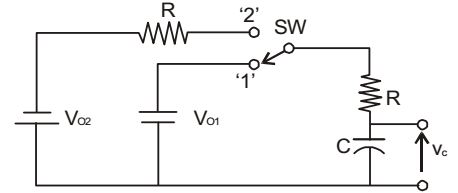-
The switch SW shown in the circuit is kept at position ‘1’ for a long duration. At t = 0+, the switch is moved to position ‘2’. Assuming | Vo2 | > | Vo1 |, the voltage vc (t) across the capacitor is

-
- Vc(t) = -Vo2(1 - e-t / 2RC - Vo1
- Vc(t) = Vo2(1 - e-t / 2RC + Vo1
- Vc(t) = -(Vo2 + Vo1) (1 - e-t / 2RC - Vo1
- Vc(t) = (Vo2 - Vo1) (1 - e-t / 2RC + Vo1
- Vc(t) = -Vo2(1 - e-t / 2RC - Vo1
Correct Option: D
When the switch SW is at position 1, the capacitor C is charged to voltage V01.
Now, when the switch SW is thrown to position 2, the circuit becomes as shown below :
VC (0-) = VC (0+) = V01
Using KVL in the circuit, we get
| V02 - 2R | - | = 0 | ||
| dt | c |
| ⇒ | = | |||
| cV02 - q | 2RC |


